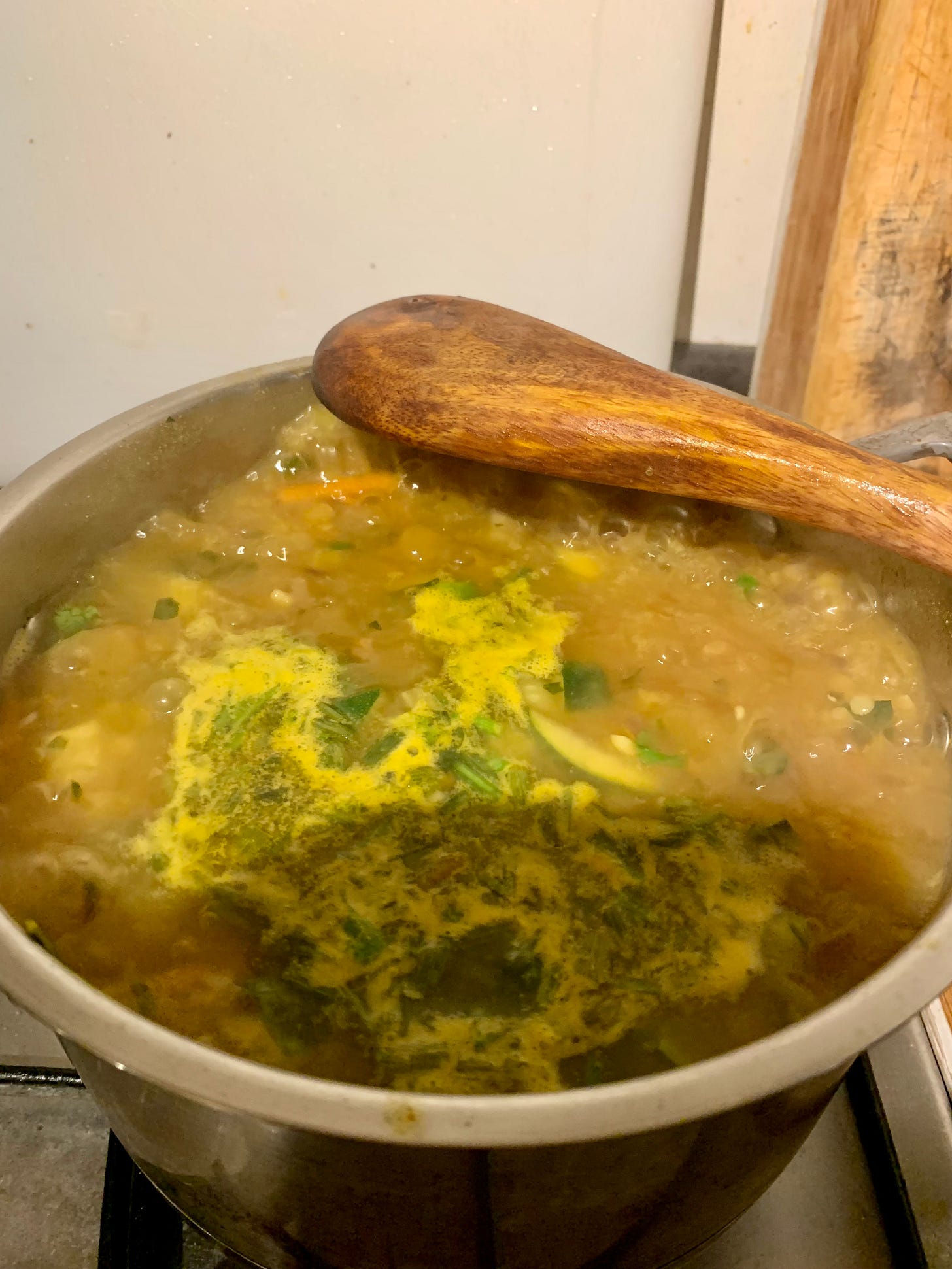December Reflections: St Nicholas the Traditions, and the Pursuit of Authentic Joy - Naked truth chapter 19
Nourishing recipe from Communist times

Talking about December—going through December—is quite an experience for Martha. So many emotions, so many memories, so much pain. Yes, pain and also bright memories. Here we go again, thinks Martha, ready to tackle another subject.
DECEMBER IS NOT THE SAME FOR ALL OF US
We speak from our experiences. We speak from our scars. We speak from our deep-rooted wounds—the ones we hide behind layers of makeup, colorful hair, and clothes. We hide and carry on. We speak from the pain, and by God, our voice is strong once we let it out—once we decide to speak up and say: This is not my experience. This is not my joy. This is not my happiness. At least not in the way the majority has to embody it.
Something fundamental has been lost over the past 40 years—a certain decency in happiness, a sense of depth, and authenticity.
If we think about Christmas, let’s remind ourselves what it truly is. It is a sacred religious celebration, a moment for introspection, something that has nothing to do with the heavy commercial weight and push. Religious fervor is a personal experience, one to share and celebrate within the sacred spaces of churches or family environments. Nobody has the right to tell us how to feel, what to do, how to celebrate, or what to buy, buy, buy.
And yet, the media, the high street, and the online world bombard us nonstop—telling us what we need to acquire to feel good, where we need to go to experience something fabulous (whether we’re interested or not), what to eat, what to drink, and so on. It’s endless.
Martha had to stop, pause, take a deep breath, and look back for a moment.
ST NICHOLAS AND THE COMMUNIST TIMES
During the Communist era, her family did not celebrate Christmas, and this was the norm at the time. She knows that some families with stronger Christian roots celebrated, but they didn’t talk widely about it. Her family celebrated St. Nicholas on December 6th and they also celebrated New Year’s Eve.
St. Nicholas was loved by us children because it was the time when he would bring them presents. But first, we had to clean and polish our boots, place them outside the door, and wait to see if he would bring us presents or a stick. He would leave a stick for the children who had been naughty during the year and presents for those who had been good.
ST NICHOLAS - TRADITIONS
She remembered some of her colleagues saying that their mothers would prepare biscuits and leave them outside the door next to a glass of milk for St. Nicholas, but that was never a tradition in her family. She thought to herself, this is one of the many, many negatives of not having access to extended families—of growing up in a family without strong traditions, without lineages that were deeply involved in the lives of their members.
However, certain specific habits were undoubtedly tied to those times, turning them into moments one looked forward to. In those times, receiving oranges, mandarins, or bananas was a huge treat. Getting Cuban candies or chewing gum was an added bonus. It was always a source of immense joy and anticipation to have the first banana, mandarin, or orange of the season. Yes, such delicacies were only available for a few months a year, and Martha remembered how each slice was savoured and appreciated.
It was unheard of to eat a whole orange on your own. No way. She remembered peeling the orange slowly, savouring the smell, the tiny drops of essential oil on her skin, breaking it into slices, and then sharing it with her parents. It was almost a sacred moment.
QUEUES WERE NORMAL
If you think such treats were easily available in shops, think again. Each kilogram of fruit came at the price of hours spent queuing in the rain or snow, hoping—praying—that there would be enough left by the time you reached the counter. The sight of a truck arriving at the back of a shop sparked a flurry of movement as a queue instantly formed. No one knew what the truck carried, but everyone knew it was something they desperately needed. It could have been sunflower oil, sugar, feta cheese, exotic fruits, or Cuban candies—those cherished fruit-flavored transparent sweets we adored. But as always in those days, there were limits. You could only buy half a kilogram, maybe one, to make it last just a little longer.
Queuing was woven into the fabric of our lives as children. Sometimes, it meant standing in line for an entire day and night—especially for meat. Families worked in shifts; children took turns with their parents. It wasn’t strange or remarkable—it was just life. I can still picture myself sitting on the cold pavement, a blanket beneath me, waiting endlessly for the truck to arrive. Lists were made to keep some order, allowing people to step away for a while to tend to other things. But you had to be back when it was time—when the lists were checked, and your turn was up.
When Martha looks back now, she realises something unexpected: joy was there, quietly present in the process. It lived in the anticipation, in the rarity of the moment, in the way these small treasures—so hard-won—meant so much more because they weren’t guaranteed. Would she be willing to go through such a process again? Yes, because back then, consumption had meaning, and every want was grounded in genuine need. Consumption had a completely different meaning then. Priorities were clearer, and the lines between needs and wants were defined not by marketing but by pure survival but survival in a good way.
FASTING IN THE CHRISTIAN ORTHODOX TRADITION
Fasting was a tradition some families observed with dedication. In the Christian Orthodox faith, fasting is guided by strict rules that outline what to eat and what to avoid, with specific times when certain foods are gradually reintroduced into the diet. There is a profound logic, almost a science, behind the process, making Christmas all the more meaningful.
These traditions, whether born out of scarcity or faith, remind Martha of the deeper meaning of the season—a meaning that often feels lost in today’s world of excess.
During the fast, certain foods are given up—meat, milk and dairy products, fish, and eggs. This abstinence is not merely about restriction but serves as a physical and spiritual detox, cleansing both body and mind. The act of self-denial cultivates discipline and mindfulness, drawing one closer to the essence of the celebration to come.
Now, imagine the joy and heightened appreciation when Christmas finally arrives, and the feast begins. After 40 days of abstaining, every flavor feels richer, every bite more satisfying. The return of these foods is more than indulgence—it is a symbolic moment of gratitude and celebration, amplifying the joy of the holiday.
Although she cannot remember abstaining for 40 days as a family they went through weeks of abstaining from meat as an exercise, and because her mother was joining some colleagues at work for a limited fasting.
Martha recalls a dish she once learned from a colleague—a lentil soup that has since become a winter staple in her kitchen. Its warmth and simplicity carry a special comfort, especially during the colder months. As the winter winds howl outside, Martha finds comfort in this simple, hearty soup—a dish steeped in memories and love
For Martha, recipes are more than instructions for cooking; they are bridges to the past. They bring back cherished memories, connect her to her roots, and serve as a quiet conversation with those who have departed from this world. Through the act of preparing these dishes, she feels a sense of continuity and belonging, as though the flavours themselves tell stories of love, tradition, and identity.
As the soup simmers, Martha thinks of all the ways we carry the past with us, even in something as simple as a recipe. It’s not just food—it’s memory, resilience, and a quiet celebration of everything that came before.
LENTIL SOUP RECIPE FOR WINTER TIME AND NOT ONLY
Hearty Lentil Soup
A nourishing and flavorful soup perfect for chilly days.
Ingredients
1 cup lentils (any variety, rinsed and drained)
1 medium onion, finely chopped
3 garlic cloves, minced
1 medium zucchini, diced
2 medium carrots, diced
2 medium potatoes, peeled and diced
1 teaspoon ground coriander
1 teaspoon ground cumin
1 tablespoon fresh parsley, chopped (plus more for garnish)
1 tablespoon laveage
6 cups vegetable stock or water
2 tablespoons olive oil or coconut oil
Salt, sweet paprika and black pepper, to taste
Instructions
Prepare the Ingredients:
Rinse the lentils under cold water and drain.
Dice the zucchini, carrots, and potatoes. Chop the onion and parsley.
Sauté the Aromatics:
In a large pot, heat the olive oil over medium heat.
Add the chopped onion and cook until translucent (about 3–4 minutes).
Stir in the minced garlic, ground coriander, and cumin. Cook for 1 minute, until fragrant.
Add Vegetables and Lentils:
Add the zucchini, carrots, and potatoes to the pot. Stir well to coat them in the spices.
Add the rinsed lentils and mix thoroughly.
Simmer the Soup:
Pour in the vegetable stock or water. Bring the mixture to a boil, then reduce the heat to low.
Cover the pot and let it simmer for 25–30 minutes, or until the lentils and vegetables are tender.
Season and Serve:
Taste the soup and season with salt and black pepper as needed.
Stir in the chopped parsley just before serving for a fresh burst of flavor.
Garnish and Enjoy:
Ladle the soup into bowls and garnish with additional parsley. Serve warm with crusty bread or on its own.
Until next time, be well!
If you find value here, please consider supporting my work by becoming a paid subscriber or you can Buy me a coffee . Also please share with other like minded people.






Thank you for the recipe. I’m loving Martha’s story